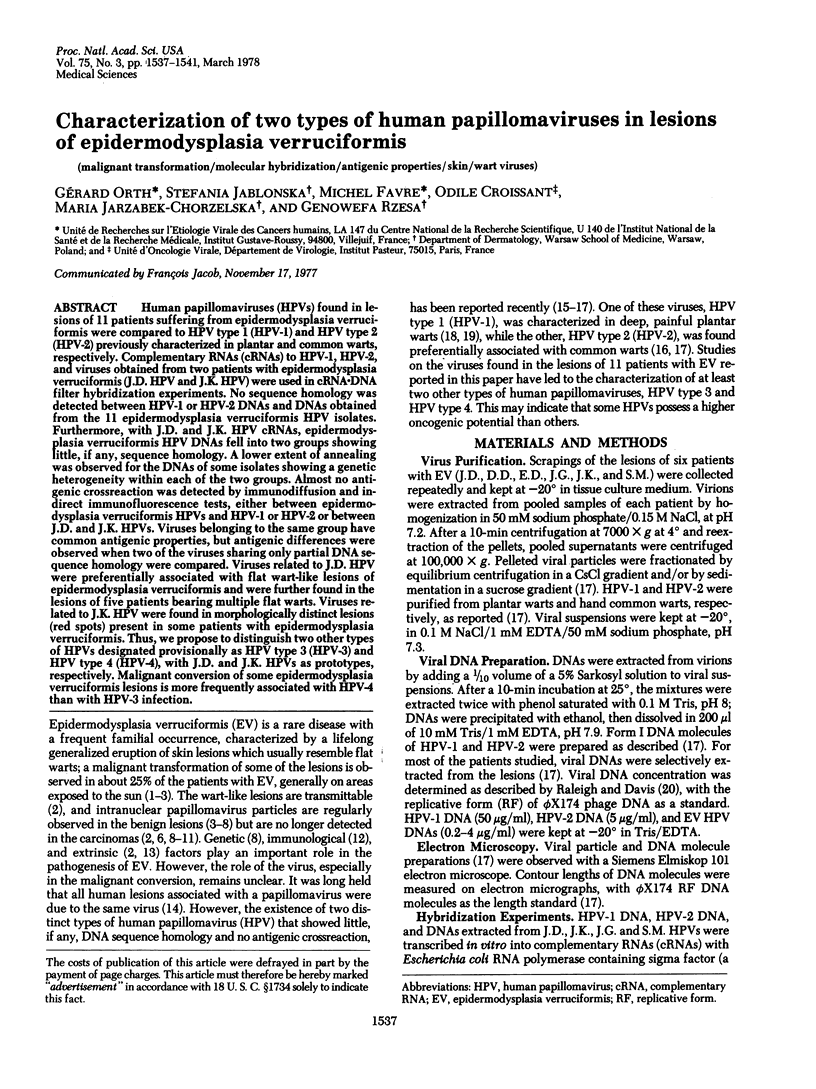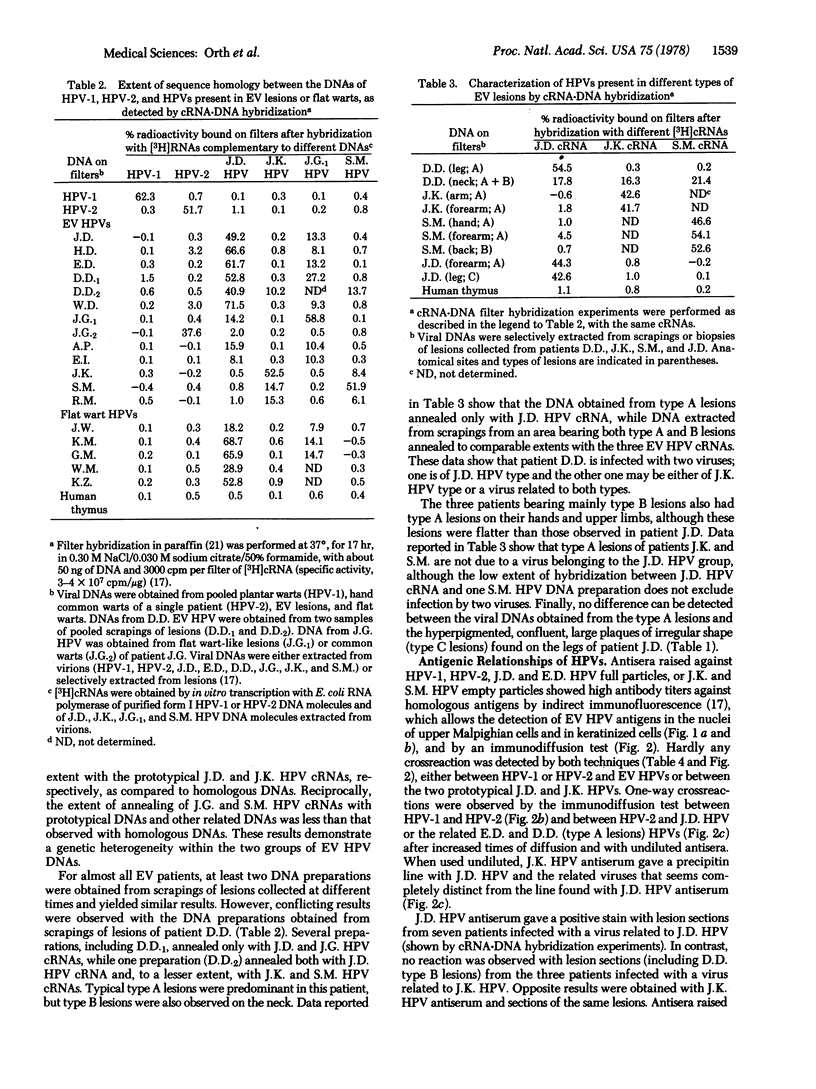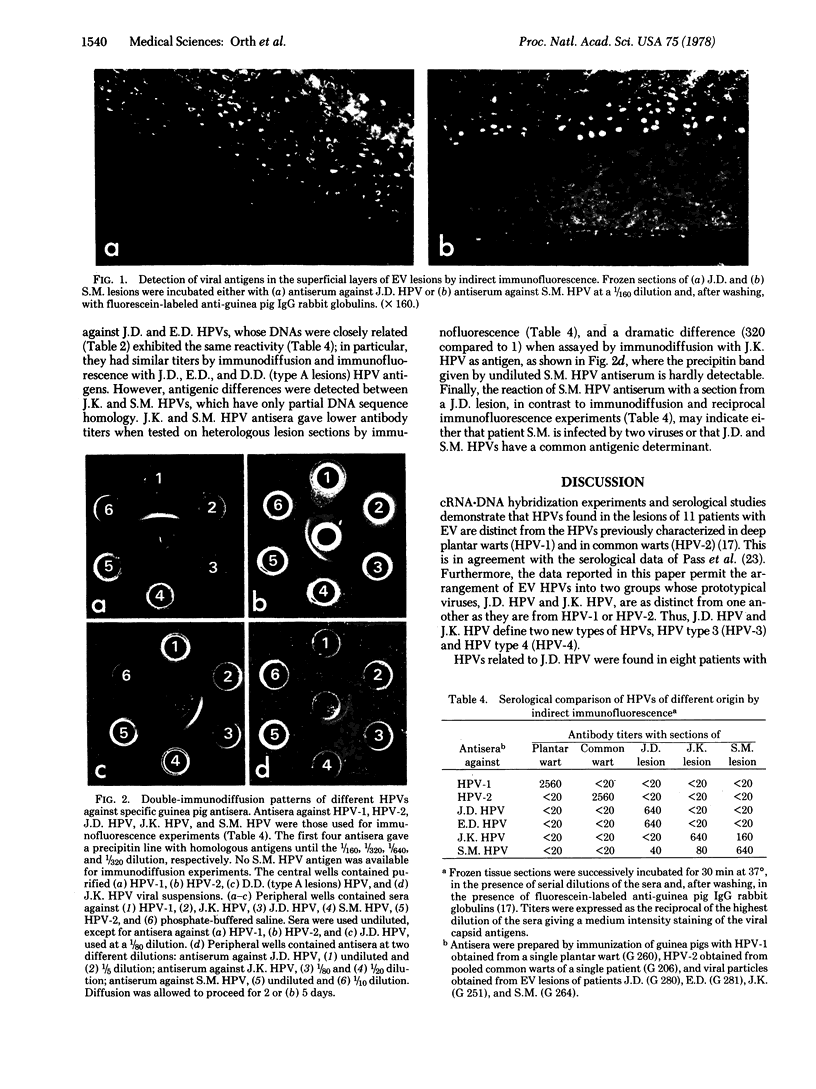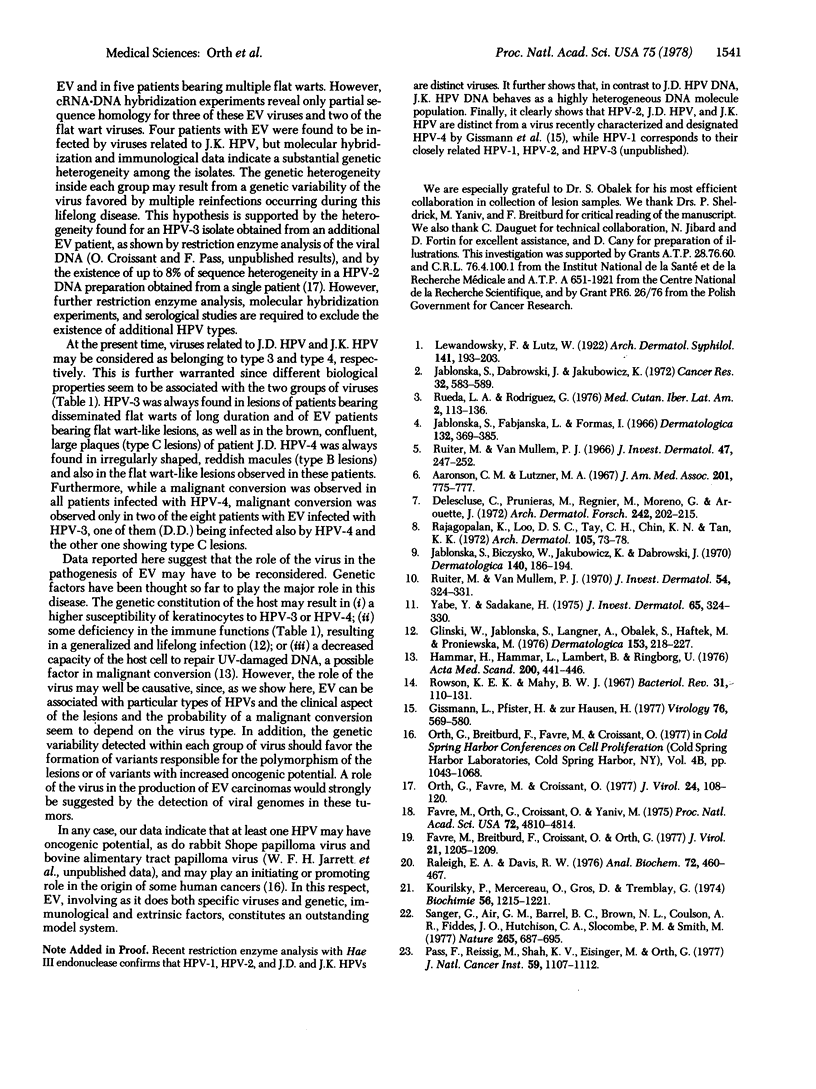Abstract
Human papillomaviruses (HPVs) found in lesions of 11 patients suffering from epidermodysplasia verruciformis were compared to HPV type 1 (HPV-1) and HPV type 2 (HPV-2) previously characterized in plantar and common warts, respectively. Complementary RNAs (cRNAs) to HPV-1, HPV-2, and viruses obtained from two patients with epidermodysplasia verruciformis (J.D. HPV and J.K. HPV) were used in cRNA·DNA filter hybridization experiments. No sequence homology was detected between HPV-1 or HPV-2 DNAs and DNAs obtained from the 11 epidermodysplasia verruciformis HPV isolates. Furthermore, with J.D. and J.K. HPV cRNAs, epidermodysplasia verruciformis HPV DNAs fell into two groups showing little, if any, sequence homology. A lower extent of annealing was observed for the DNAs of some isolates showing a genetic heterogeneity within each of the two groups. Almost no antigenic crossreaction was detected by immunodiffusion and indirect immunofluorescence tests, either between epidermodysplasia verruciformis HPVs and HPV-1 or HPV-2 or between J.D. and J.K. HPVs. Viruses belonging to the same group have common antigenic properties, but antigenic differences were observed when two of the viruses sharing only partial DNA sequence homology were compared. Viruses related to J.D. HPV were preferentially associated with flat wart-like lesions of epidermodysplasia verruciformis and were further found in the lesions of five patients bearing multiple flat warts. Viruses related to J.K. HPV were found in morphologically distinct lesions (red spots) present in some patients with epidermodysplasia verruciformis. Thus, we propose to distinguish two other types of HPVs designated provisionally as HPV type 3 (HPV-3) and HPV type 4 (HPV-4), with J.D. and J.K. HPVs as prototypes, respectively. Malignant conversion of some epidermodysplasia verruciformis lesions is more frequently associated with HPV-4 than with HPV-3 infection.
Keywords: malignant transformation, molecular hybridization, antigenic properties, skin, wart viruses
Full text
PDF




Images in this article
Selected References
These references are in PubMed. This may not be the complete list of references from this article.
- Aaronson C. M., Lutzner M. A. Epidermodysplasia verruciformis and epidermoid carcinoma. Electron microscopic observations. JAMA. 1967 Sep 4;201(10):775–777. [PubMed] [Google Scholar]
- Delescluse C., Prunieras M., Regnier M., Moreno G., Arouete J. Epidermodysplasia verruciformis. I. Electron microscope autoradiography and tissue culture studies. Arch Dermatol Forsch. 1972;242(2):202–215. [PubMed] [Google Scholar]
- Favre M., Breitburd F., Croissant O., Orth G. Chromatin-like structures obtained after alkaline disruption of bovine and human papillomaviruses. J Virol. 1977 Mar;21(3):1205–1209. doi: 10.1128/jvi.21.3.1205-1209.1977. [DOI] [PMC free article] [PubMed] [Google Scholar]
- Favre M., Orth G., Croissant O., Yaniv M. Human papillomavirus DNA: physical map. Proc Natl Acad Sci U S A. 1975 Dec;72(12):4810–4814. doi: 10.1073/pnas.72.12.4810. [DOI] [PMC free article] [PubMed] [Google Scholar]
- Gissmann L., Pfister H., Zur Hausen H. Human papilloma viruses (HPV): characterization of four different isolates. Virology. 1977 Feb;76(2):569–580. doi: 10.1016/0042-6822(77)90239-2. [DOI] [PubMed] [Google Scholar]
- Gliński W., Jablonska S., Langner A., Obalek S., Haftek M., Proniewska M. Cell-mediated immunity in epidermodysplasia verruciformis. Dermatologica. 1976;153(4):218–227. doi: 10.1159/000251060. [DOI] [PubMed] [Google Scholar]
- Hammar H., Hammar L., Lambert L., Ringborg U. A case report including EM and DNA repair investigations in a dermatosis associated with multiple skin cancers: epidermodysplasia verruciformis. Acta Med Scand. 1976;200(6):441–446. doi: 10.1111/j.0954-6820.1976.tb08261.x. [DOI] [PubMed] [Google Scholar]
- Jablonska S., Dabrowski J., Jakubowicz K. Epidermodysplasia verruciformis as a model in studies on the role of papovaviruses in oncogenesis. Cancer Res. 1972 Mar;32(3):583–589. [PubMed] [Google Scholar]
- Jablonska S., Fabjanska L., Formas I. On the viral etiology of epidermodysplasia verruciformis. Dermatologica. 1966;132(5):369–385. doi: 10.1159/000254437. [DOI] [PubMed] [Google Scholar]
- Jablońska S., Biczysko W., Jakubowicz K., Dabrowski H. The ultrastructure of transitional states to Bowen's disease and invasive Bowen's carcinoma in epidermodysplasia verruciformis. Dermatologica. 1970;140(3):186–194. doi: 10.1159/000252551. [DOI] [PubMed] [Google Scholar]
- Kourilsky P., Mercereau O., Gros D., Tremblay G. Hybridization of filters with competitor DNA in the liquid phase in a standard and a micro-assay. Biochimie. 1974;56(9):1215–1221. doi: 10.1016/s0300-9084(74)80014-3. [DOI] [PubMed] [Google Scholar]
- Orth G., Favre M., Croissant O. Characterization of a new type of human papillomavirus that causes skin warts. J Virol. 1977 Oct;24(1):108–120. doi: 10.1128/jvi.24.1.108-120.1977. [DOI] [PMC free article] [PubMed] [Google Scholar]
- Pass F., Reissig M., Shah K. V., Eisinger M., Orth G. Identification of an immunologically distinct papillomavirus from lesions of epidermodysplasia verruciformis. J Natl Cancer Inst. 1977 Oct;59(4):1107–1112. doi: 10.1093/jnci/59.4.1107. [DOI] [PubMed] [Google Scholar]
- Rajagopalan K., Bahru J., Loo D. S., Tay C. H., Chin K. N., Tan K. K. Familial epidermodysplasia verruciformis of Lewandowsky and Lutz. Arch Dermatol. 1972 Jan;105(1):73–78. [PubMed] [Google Scholar]
- Raleigh E. A., Davis R. W. Determination of DNA concentration by electron microscopy. Anal Biochem. 1976 May 7;72:460–467. doi: 10.1016/0003-2697(76)90554-6. [DOI] [PubMed] [Google Scholar]
- Rowson K. E., Mahy B. W. Human papova (wart) virus. Bacteriol Rev. 1967 Jun;31(2):110–131. doi: 10.1128/br.31.2.110-131.1967. [DOI] [PMC free article] [PubMed] [Google Scholar]
- Ruiter M., van Mullem P. J. Behavior of virus in malignant degeneration of skin lesion in epidermodysplasia verruciformis. J Invest Dermatol. 1970 Apr;54(4):324–331. doi: 10.1111/1523-1747.ep12258641. [DOI] [PubMed] [Google Scholar]
- Ruiter M., van Mullem P. J. Demonstration by electronmicroscopy of an intranuclear virus in epidermodysplasia verruciformis. J Invest Dermatol. 1966 Sep;47(3):247–252. doi: 10.1038/jid.1966.137. [DOI] [PubMed] [Google Scholar]
- Sanger F., Air G. M., Barrell B. G., Brown N. L., Coulson A. R., Fiddes C. A., Hutchison C. A., Slocombe P. M., Smith M. Nucleotide sequence of bacteriophage phi X174 DNA. Nature. 1977 Feb 24;265(5596):687–695. doi: 10.1038/265687a0. [DOI] [PubMed] [Google Scholar]
- Yabe Y., Sadakane H. The virus of epidermodysplasia verruciformis: electron microscopic and fluorescent antibody studies. J Invest Dermatol. 1975 Sep;65(3):324–330. doi: 10.1111/1523-1747.ep12598388. [DOI] [PubMed] [Google Scholar]





